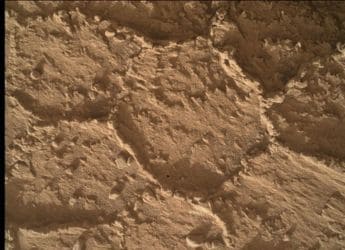- Home
- Science
- Science News
- NASA DART Team Confirms Target Asteroid Dimorphos' Orbit Ahead of Impact
NASA DART Team Confirms Target Asteroid Dimorphos' Orbit Ahead of Impact
If NASA's DART spacecraft successfully alters the asteroid’s path, Dimorphos will move closer to Didymos, its parent asteroid.

Photo Credit: NASA/Johns Hopkins, APL/Steve Gribben
NASA's attempt to impact Dimorphos is expected to shorten the time it takes to orbit Didymos
NASA's Double Asteroid Redirection Test (DART) team has completed an observation campaign to confirm the orbit of DART's target asteroid Dimorphos. DART is a spacecraft designed to impact an asteroid as part of a test to verify if the method can be effective in changing the course of an asteroid in the future, for planetary defense. The latest campaign was undertaken using world's most powerful telescopes and supports the team's calculations to zero in on Dimorphos' orbit. The calculations were made in early 2021 and are crucial for ensuring that DART arrives at the right place and the right time for an effective impact.
According to NASA, ensuring the right impact by DART isn't the only reason to understand the dynamics of Dimorphos. If DART successfully alters the asteroid's path, Dimorphos will move closer to Didymos, its parent asteroid. This will shorten the time Dimorphos takes to orbit Didymos. While measuring this change in path isn't a problem, the team will have to ensure that nothing else than the impact is affecting the orbit.
Other factors that can bring a change in the path include radiation recoil from the Sun-warmed surface of the asteroid. This force can give a gentle push to the asteroid which can lead to a change in its orbit.
We've got a date with that dot. Using ground telescopes, the #DARTMission confirmed the orbit of asteroid Didymos.
— NASA (@NASA) August 26, 2022
DART is scheduled to impact Didymos' moonlet Dimorphos on Sept. 26. The asteroids and this test of planetary defense pose no risk to Earth: https://t.co/DLy1DZwyzS pic.twitter.com/qeCon6f5Fg
“The before-and-after nature of this experiment requires exquisite knowledge of the asteroid system before we do anything to it. We don't want to, at the last minute, say, ‘Oh, here's something we hadn't thought about or phenomena we hadn't considered.' We want to be sure that any change we see is entirely due to what DART did,” said Nick Moskovitz, an astronomer with Lowell Observatory in Flagstaff, Arizona. He co-led the July observation campaign.
At the time of DART's impact, which is estimated to take place in late September or early October, Dimorphos and Didymos will make their closest approach to Earth in recent years, coming roughly 10.8 million kilometres near our planet.
The system of the two asteroids had been out of range for most ground-based telescopes since Mars 2021. Hence, the team used powerful telescopes for its observations campaign. They noted a total of 11 changes in the system called mutual events and studying these changes allowed them to determine the time Dimorphos takes to orbit its parent asteroid. In addition, it also helped predict the position of Dimorphos in specific moments of time including when DART will impact.
Get your daily dose of tech news, reviews, and insights, in under 80 characters on Gadgets 360 Turbo. Connect with fellow tech lovers on our Forum. Follow us on X, Facebook, WhatsApp, Threads and Google News for instant updates. Catch all the action on our YouTube channel.
Related Stories
- Samsung Galaxy Unpacked 2025
- ChatGPT
- Redmi Note 14 Pro+
- iPhone 16
- Apple Vision Pro
- Oneplus 12
- OnePlus Nord CE 3 Lite 5G
- iPhone 13
- Xiaomi 14 Pro
- Oppo Find N3
- Tecno Spark Go (2023)
- Realme V30
- Best Phones Under 25000
- Samsung Galaxy S24 Series
- Cryptocurrency
- iQoo 12
- Samsung Galaxy S24 Ultra
- Giottus
- Samsung Galaxy Z Flip 5
- Apple 'Scary Fast'
- Housefull 5
- GoPro Hero 12 Black Review
- Invincible Season 2
- JioGlass
- HD Ready TV
- Laptop Under 50000
- Smartwatch Under 10000
- Latest Mobile Phones
- Compare Phones
- OnePlus 15R
- Realme Narzo 90x 5G
- Realme Narzo 90 5G
- Vivo S50 Pro Mini
- Vivo S50
- OPPO Reno 15c
- Redmi Note 15 5G
- Redmi Note 15 Pro 5G
- Asus ProArt P16
- MacBook Pro 14-inch (M5, 2025)
- Infinix Xpad Edge
- OnePlus Pad Go 2
- OnePlus Watch Lite
- Just Corseca Skywatch Pro
- Acerpure Nitro Z Series 100-inch QLED TV
- Samsung 43 Inch LED Ultra HD (4K) Smart TV (UA43UE81AFULXL)
- Asus ROG Ally
- Nintendo Switch Lite
- Haier 1.6 Ton 5 Star Inverter Split AC (HSU19G-MZAID5BN-INV)
- Haier 1.6 Ton 5 Star Inverter Split AC (HSU19G-MZAIM5BN-INV)

















